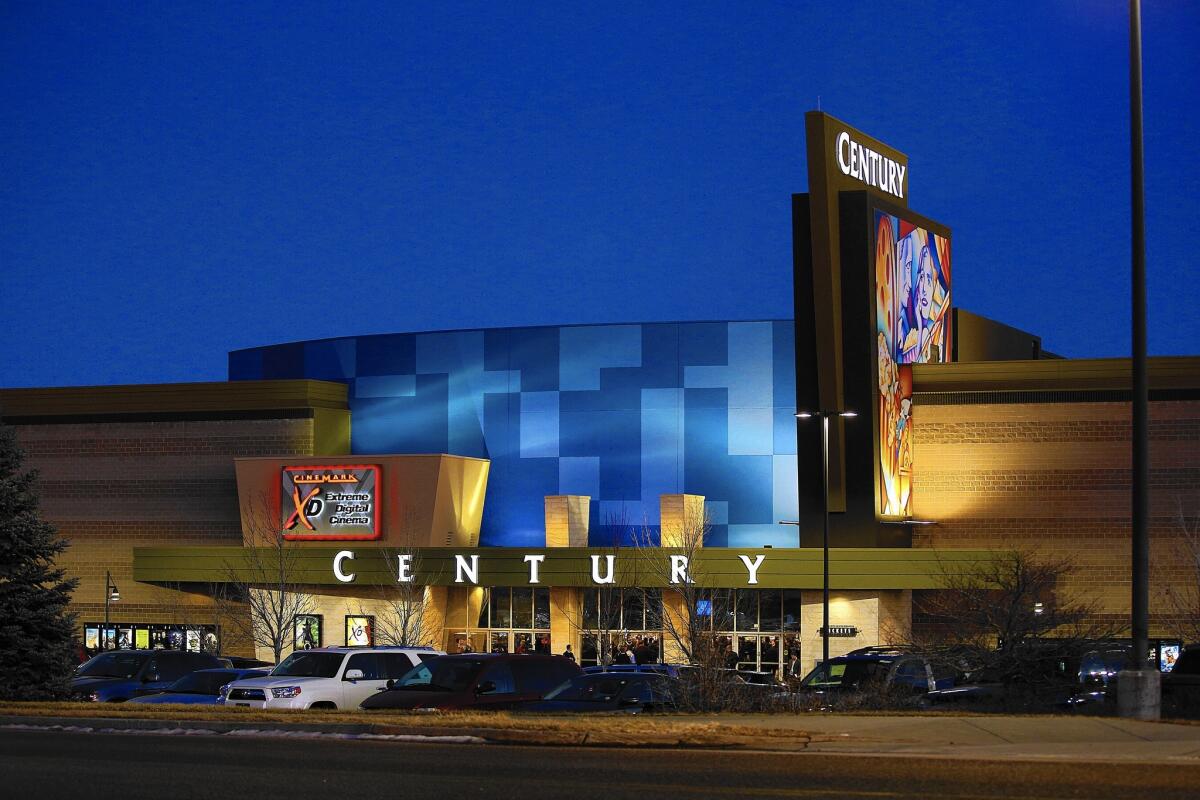Only fictional horror fills Aurora theater today, but tragedy lingers

The Aurora, Colo., theater where 12 were killed in 2012 has been remodeled and the name has been changed to the Century Aurora 16.
- Share via
Reporting from AURORA, Colo. — Gunshots rang out in the auditorium formerly known as Theater 9. And screams. More weapons blasted. But on this balmy Friday night, when the doors swung open, there were no bodies, no blood, no shooter, no horror.
Just a small, happy crowd leaving the latest summer blockbuster, peeling off 3-D glasses and chattering about the prehistoric villains of “Jurassic World,” fictional monsters that stayed on the big screen where they belonged.
On July 20, 2012, at a midnight showing of another summer blockbuster, “The Dark Knight Rises,” James E. Holmes burst into Theater 9, swathed in black protective gear, loaded with ammunition, guns at the ready. The plan: to kill as many people as possible. The reason: to make him feel better.
Holmes slaughtered 12 moviegoers and wounded 70 others that night. Most who survived have testified against him over the last two months in a lengthy trial that could send him to Colorado’s death chamber. He acknowledges that he planned and carried out the rampage but pleaded not guilty by reason of insanity.
The theater has since been remodeled, but memories of the mass shooting, one of the worst in American history, are never far away.
“It’s like every time we come see a movie, we have to watch our back,” said Marychris Sept, 17, who was trying to decide between “Jurassic World” and “Inside Out.” “It feels like it could happen again.”
Hours earlier, the prosecution rested its case against Holmes in Division 201 of the Arapahoe County Justice Center. This week, defense attorneys began presenting evidence to prove why the gunman, who is now 27, should not be found guilty of 166 charges and die by lethal injection.
A scale model of Theater 9 has been parked between the witness stand and the jury box in Division 201. Its 421 blue seats are pocked with white, the pale markers showing where bullets tore through people and fabric. Witnesses to the carnage have used the model while testifying to show jurors where they were sitting when their lives were forever altered.
For the most part, changes to the multiplex in this Denver suburb seem largely cosmetic. The theater’s footprint and layout remain the same. A single word was added to its name when the movie house reopened six months after the shooting; the former Century 16 is now the Century Aurora 16.
The auditoriums are now known by letters instead of numbers; Theater 1 became House A. The neon facade has been replaced by a muted mural of a film reel, a big screen and popcorn.
Theater 9 has been transformed into an XD venue, also known as Extreme Digital Cinema. Its bigger screen has reduced the number of available seats to 354, all new. Eight days ago, fewer than half of them were full.
If you did not know which auditorium was shot up during Holmes’ rampage, you would be hard-pressed to find out from anyone working here. Ask a ticket taker and the squishy reply will be some version of: “Theater 9? I don’t know. I just started here.”
Spend too much time talking to patrons in the vast parking lot, and a neatly suited manager will ask you to stop with a gentle explanation: “It’s a sensitive issue.”
Twenty federal lawsuits representing 40 victims or family members have been filed against Cinemark, the theater’s parent company. The cases have been consolidated, and the civil trial is set to begin July 11, 2016. The company, which did not respond to requests for comment, has also been sued in state court.
Cinemark tried to get the federal case thrown out, but in August, U.S. District Judge R. Brooke Jackson ruled that the trial should continue. In his decision, Jackson summarized what is at issue in two succinct sentences:
“Plaintiffs’ contention is that the injuries and deaths could have been prevented had the defendants taken reasonable steps to provide security for the theater on that evening,” Jackson wrote. “Defendants’ response is that the shootings, which were carefully planned and carried out, were so unprecedented as to be legally unforeseeable.”
Christina M. Habas and Michael Keating represent about half the victims and survivors who have sued Cinemark.
But Habas, a former Colorado state judge, has an even closer relationship to the shooting. She coaches the mock trial team at Aurora Central High School.
“A lot of my kids were in that theater” when Holmes began shooting, Habas said, and one texted her that night.
“A couple of them are still very, very, very shaken up, but none were physically injured,” said Habas, whose students were in Theater 9, where the majority of the carnage occurred, and Theater 8, where bullets came through the walls and injured people in the audience.
“It touched a lot of people,” she said. “A horrible, horrible tragedy. It’s a big deal in that community.”
Still.
More to Read
Sign up for Essential California
The most important California stories and recommendations in your inbox every morning.
You may occasionally receive promotional content from the Los Angeles Times.














